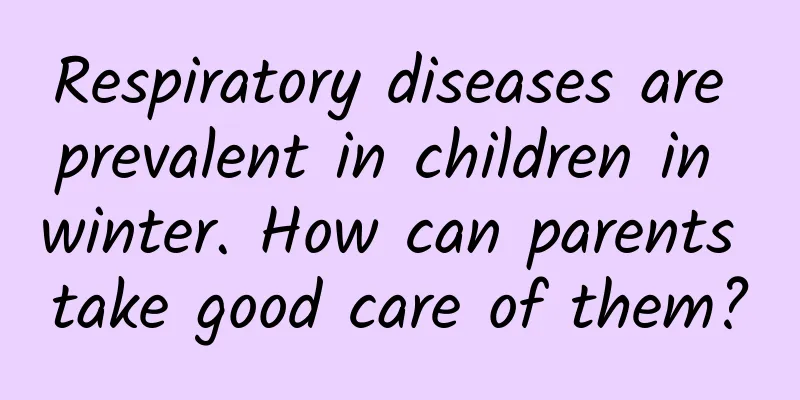Respiratory diseases are prevalent in children in winter. How can parents take good care of them?

|
Recently, as the winter weather has become colder, many people have developed respiratory disease symptoms to varying degrees, the most common of which is children's respiratory disease. Even in pediatrics, emergency departments, internal medicine and other departments across the country, the number of children visiting the hospital has increased significantly, and symptoms such as cough, fever, and sore throat have also appeared. Winter is the peak season for respiratory diseases, and children's own resistance is weak, so they are prone to respiratory diseases. How should parents deal with the high incidence of respiratory diseases in children? What are the main clinical manifestations? How should parents scientifically prevent respiratory diseases in daily life? Now, follow the editor to learn more. The picture comes from the Internet 1. What are the common respiratory diseases in children in winter? 1.1 Bronchitis Bronchitis is a common respiratory disease in children, mainly caused by viral infection. In the cold winter, children's immunity is weak and they are easily attacked by cold viruses, which in turn causes bronchitis. Bronchitis can be divided into two types: acute and chronic. Acute bronchitis usually presents with symptoms such as cough, dyspnea, chest tightness, and fever. Coughs are often dry coughs or sputum, and the sputum is usually yellow or green, sometimes accompanied by symptoms such as increased breath sounds and a sunken sternum. Chronic bronchitis refers to recurrent coughs and sputum coughs that last longer and are more complicated. The picture comes from the Internet 1.2 Influenza Influenza is an acute respiratory infectious disease caused by influenza virus, and its main symptoms include fever, cough, sore throat, nasal congestion, runny nose, fatigue, etc. There are multiple subtypes of influenza virus, and different epidemic subtypes appear every year, making people susceptible to infection. Children are a high-risk group for influenza because their immune systems are not fully developed and their resistance is weak. In addition, children are usually exposed to more viruses in crowded places such as schools and kindergartens, increasing the risk of infection. The main way that influenza is transmitted is through respiratory droplets, such as when coughing or sneezing, droplets containing the virus are released and then inhaled by others. In addition, influenza viruses can also be transmitted to others through direct contact with contaminated objects. Therefore, maintaining good personal hygiene habits, such as washing hands frequently and avoiding close contact with patients, can effectively reduce the spread of influenza. The picture comes from the Internet 2. How can parents provide good care? 2.1 Create a good indoor environment Keep the air fresh: Open windows regularly to ensure good indoor air circulation. In addition, parents can consider using an air purifier to filter out pollutants and allergens in the air. Avoid smoke and harmful gases: Smoking is prohibited indoors, and cleaning agents, candles and aromatherapy products containing harmful gases are avoided. These items release harmful chemicals and have adverse effects on children's respiratory system. Maintain appropriate room temperature and humidity: Make sure the indoor temperature and humidity are appropriate, and avoid overheating or overcooling. Excessive temperature and humidity may cause mold and mites to breed, posing a threat to children's respiratory health. Reduce indoor pollution sources: Parents should try to reduce indoor pollution sources, such as volatile organic compounds (VOCs) and formaldehyde, etc. Choose environmentally friendly furniture and decoration materials, and regularly clean and maintain indoor equipment to reduce the release of harmful substances. Keep the house clean: Keep the house clean and tidy, and clean the floors, furniture and bedding regularly. This will help reduce the accumulation of dust, bacteria and allergens, thereby reducing your child's risk of respiratory infections. Avoid high humidity levels: High humidity can easily lead to mold growth, which can threaten your child's respiratory health. Using a dehumidifier or maintaining good ventilation can help control humidity levels. The picture comes from the Internet 2.2 Strengthen children’s physical exercise and immunity Encourage children to actively participate in physical exercise and outdoor activities. Moderate exercise can enhance children's lung function and cardiovascular system, improve the body's resistance. Choose some sports suitable for children, such as swimming, running, skipping rope, etc., and insist on exercising for a certain time every day. Parents should also pay attention to children's diet and nutrition. A reasonable diet can provide sufficient nutrients, enhance children's immunity, ensure that children take in enough protein, vitamins and minerals, and eat more fresh vegetables, fruits and protein-rich foods such as fish, chicken, beans, etc. In addition, parents should avoid giving children too much fried food and high-sugar food to avoid affecting their health. In addition, parents should strengthen children's personal hygiene habits and educate them to develop good habits of washing hands frequently, ventilating frequently, and keeping indoor air fresh. In addition, the home should be kept clean and tidy, and dust and foreign objects in the home environment should be cleaned up in time to reduce pollutants in the air. You can also consider giving children some health products that enhance immunity appropriately, but you should be cautious when choosing health products. It is best to consult a doctor for advice and follow the doctor's instructions. 2.3 Pay attention to children’s clothing and warmth Choose appropriate clothing: For children with respiratory diseases, it is important to wear clothing that is appropriate for the weather conditions. Make sure the clothing is soft and breathable to help the child stay warm and comfortable. Choose loose clothing and avoid restrictive and tight clothing to reduce breathing restrictions. Keep warm: In cold weather, especially when children have respiratory diseases, it is very important to keep warm. Make sure your child wears a suitable coat, hat and gloves to prevent the body from overcooling. Keeping the room temperature indoors and using a humidifier to increase the humidity in the air is also a good choice to help relieve the symptoms of children's respiratory diseases. Avoid cold and humid environments: Avoid exposing children to cold and humid environments, which may aggravate children's respiratory symptoms. Make sure the rooms in your home are warm and dry, especially the children's bedrooms. In humid seasons or areas, pay special attention to preventing and controlling indoor humidity. The picture comes from the Internet 2.4 Pay attention to personal hygiene and preventive measures Personal hygiene is essential to prevent and control the spread of respiratory diseases. Parents should teach their children the correct way to wash their hands and encourage them to wash their hands frequently, especially after touching objects that may carry pathogens or after being outdoors. In addition, parents should ensure that their children maintain good cough and sneeze etiquette, such as covering their mouth and nose with a tissue or elbow to avoid the spread of viruses or bacteria. Avoiding crowded places can reduce children's risk of respiratory infections. Especially during seasonal changes, climate changes, and high influenza seasons, parents should try to avoid taking their children to crowded places, such as shopping malls, cinemas, and crowded playgrounds. In addition, parents should also limit their children's contact with sick people to prevent them from being exposed to infectious pathogens. 2.5 Close observation and timely medical treatment Parents should closely observe changes in children's symptoms. Common symptoms of respiratory diseases include coughing, sneezing, runny nose, sore throat, fever, etc. If children have these symptoms, parents should record them in time and observe changes in symptoms, such as whether the frequency and severity of coughing increase, whether the color of nasal discharge changes, etc. These observations can help doctors more accurately judge the condition and take appropriate treatment measures. Parents should consult a doctor in time and take appropriate measures according to the doctor's advice. If parents observe that the child's symptoms have a tendency to worsen significantly or other unusual symptoms appear, they should contact the doctor immediately for consultation. Doctors can judge the type and severity of the disease based on symptoms and physical examination results, and give corresponding treatment recommendations. Parents should follow the doctor's instructions for treatment, pay close attention to changes in the child's condition, and report to the doctor in time. Conclusion: With proper care and preventive measures, we can create a healthy breathing environment for children so that they can thrive. Let us work together to protect the health of our children. |
<<: Does hypertension mean taking medicine for life?
>>: Beware! This thermos cup turns hot water into "toxic water", and some people still use it
Recommend
The fastest massage to stop menstrual bleeding
All medicines are poisonous. Sometimes some medic...
What are the symptoms of a pregnant woman giving birth to a girl?
During pregnancy, many changes occur in the body ...
White discharge from the vulva
Gynecological diseases are really painful for wom...
What's wrong with breathing through your mouth?
Recently, there has been a lot of discussion abou...
Lung cancer is no longer limited to old smokers. What can we do to prevent early-stage lung cancer from being discovered?
People need oxygen to survive, and good breathing...
What to eat during lactation to stimulate milk production
Breast milk is the first natural food for the nor...
[A science class you can listen to] "Qi" Miao Popular Science" There are some things to pay attention to when drinking water in summer, be careful when using these types of water cups!
Your browser does not support the audio tag Click...
Should you eat first or brush your teeth first when you wake up in the morning? This is actually a big question!
What is the first thing to do when you wake up in...
What should I do if my girlfriend has her period?
For male friends who have girlfriends, they alway...
What is dietary fiber? What are the functions of dietary fiber?
As modern people eat more refined and softer food...
What is the reason for spots on the face after giving birth?
Pregnancy is a happy and wonderful thing, but whe...
Hypertension and stroke
Hypertension means that the pressure exerted by b...
Can cerebral palsy be detected during pregnancy?
Pregnancy is the most sacred moment for a woman. ...
What nutritional supplements should you take during pregnancy
After pregnancy, you must pay more attention to p...
How to read the results of cervical smear test and precautions
The female cervix is actually very fragile. If ...









